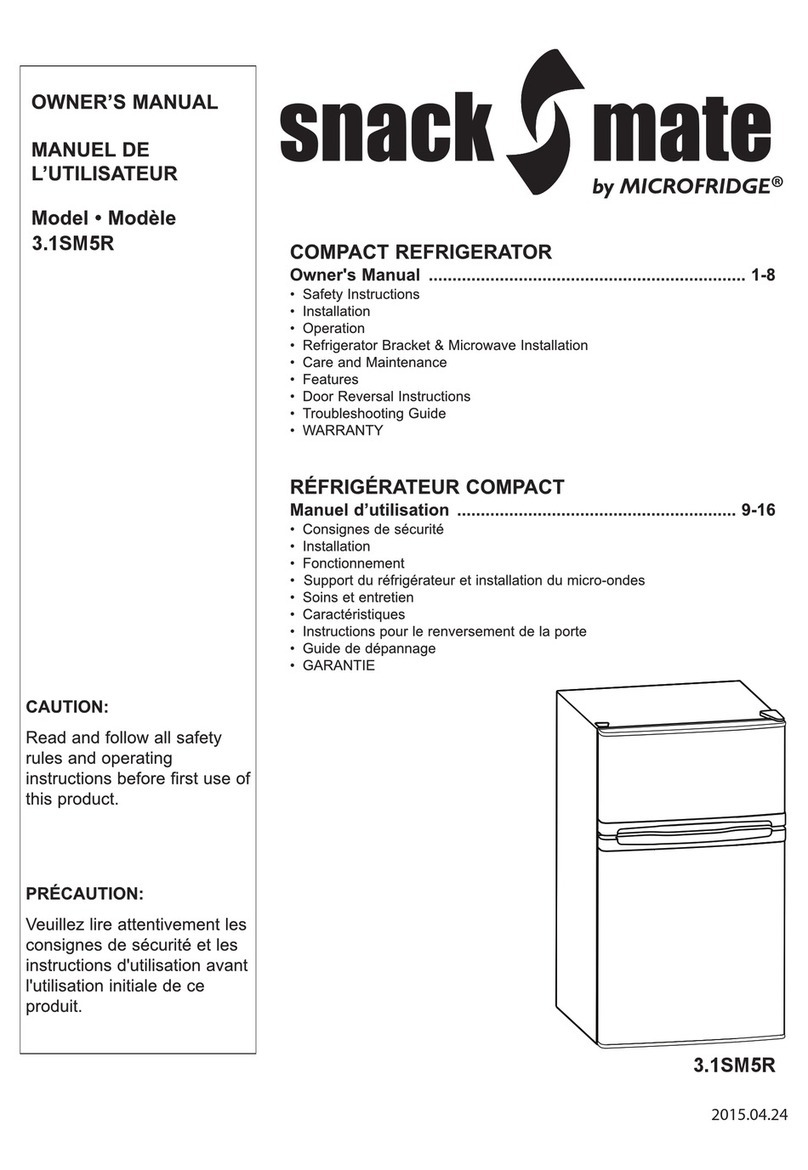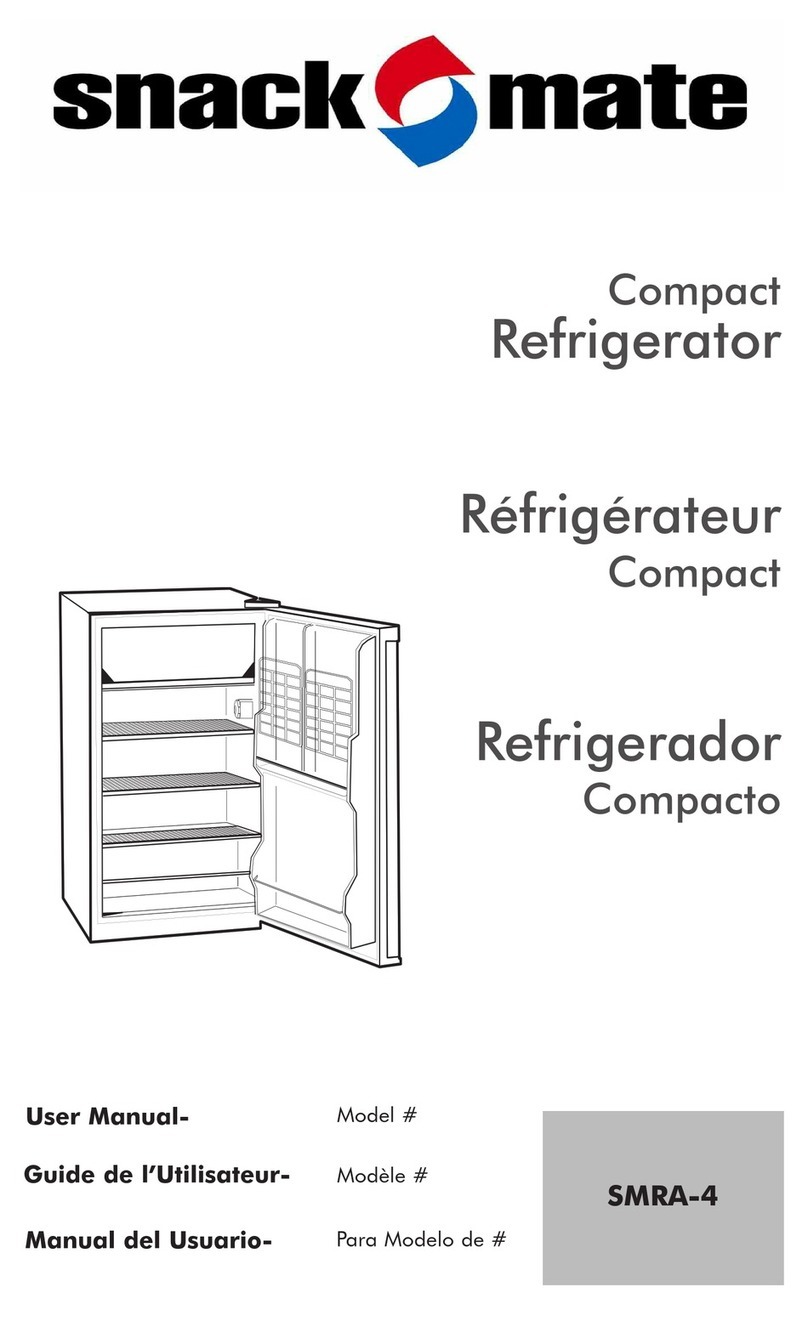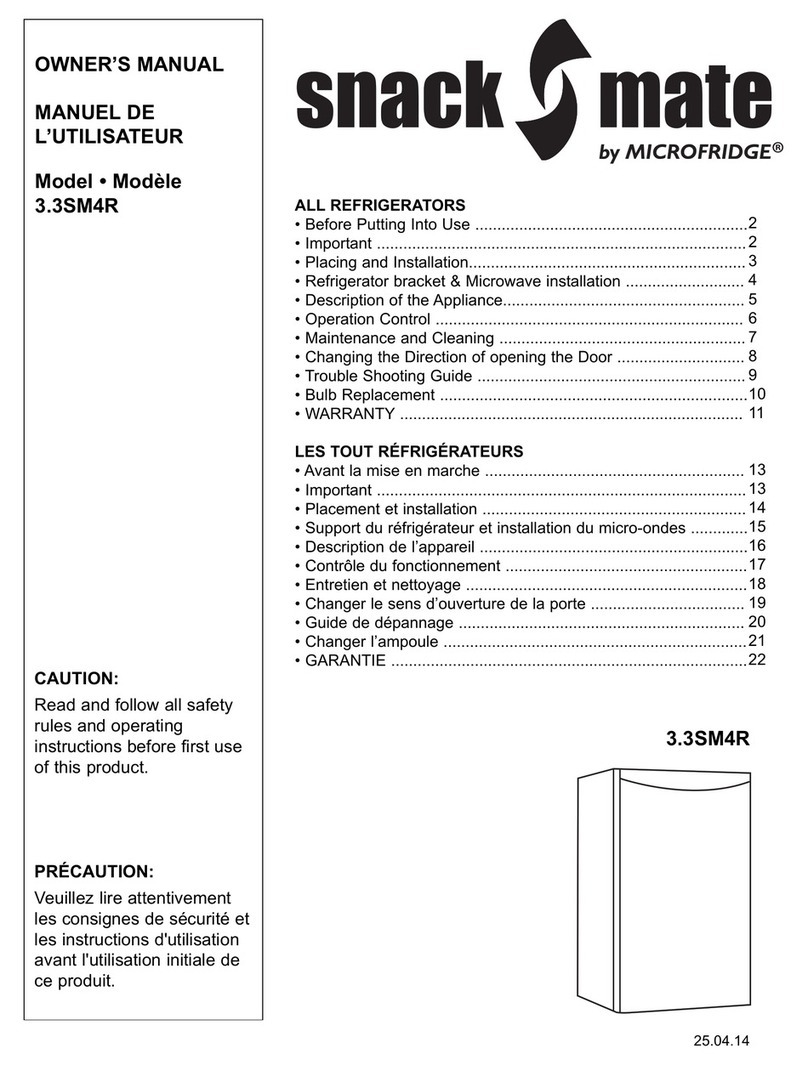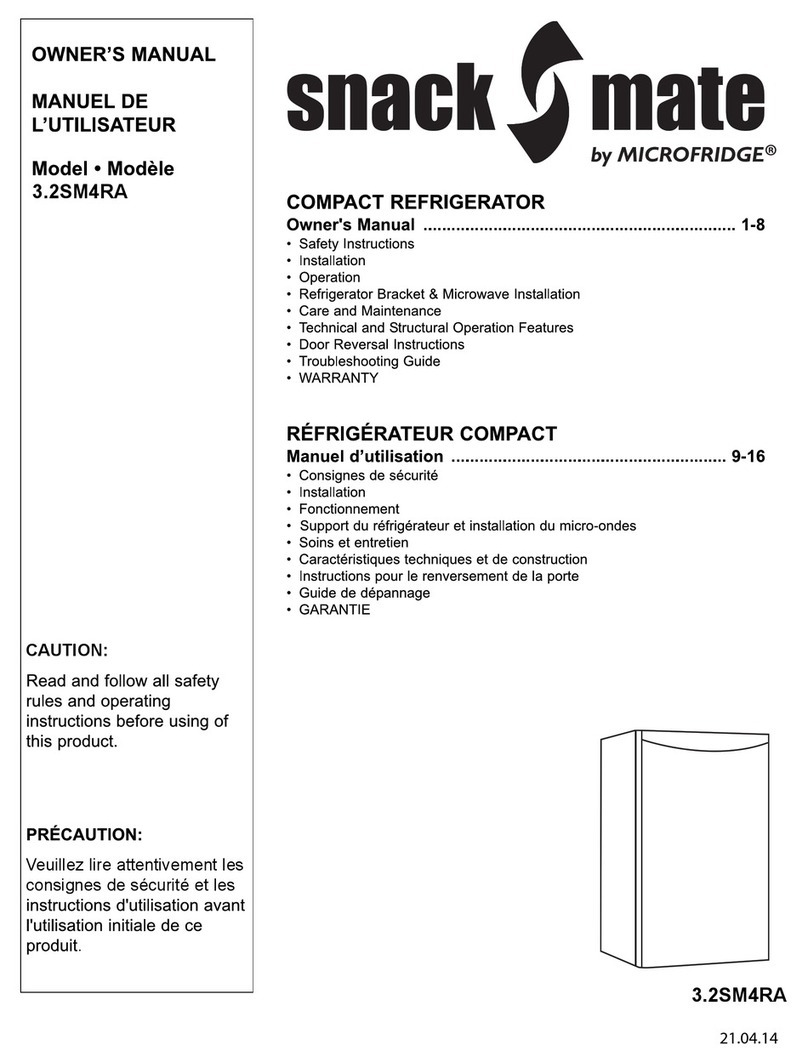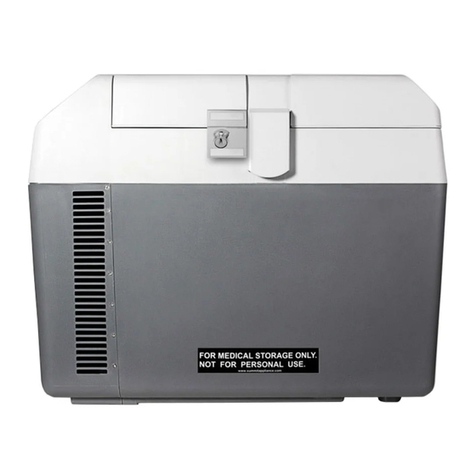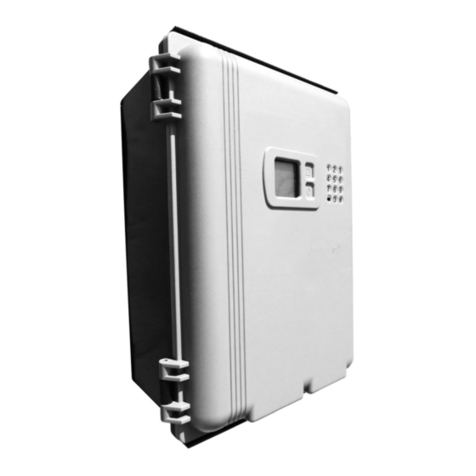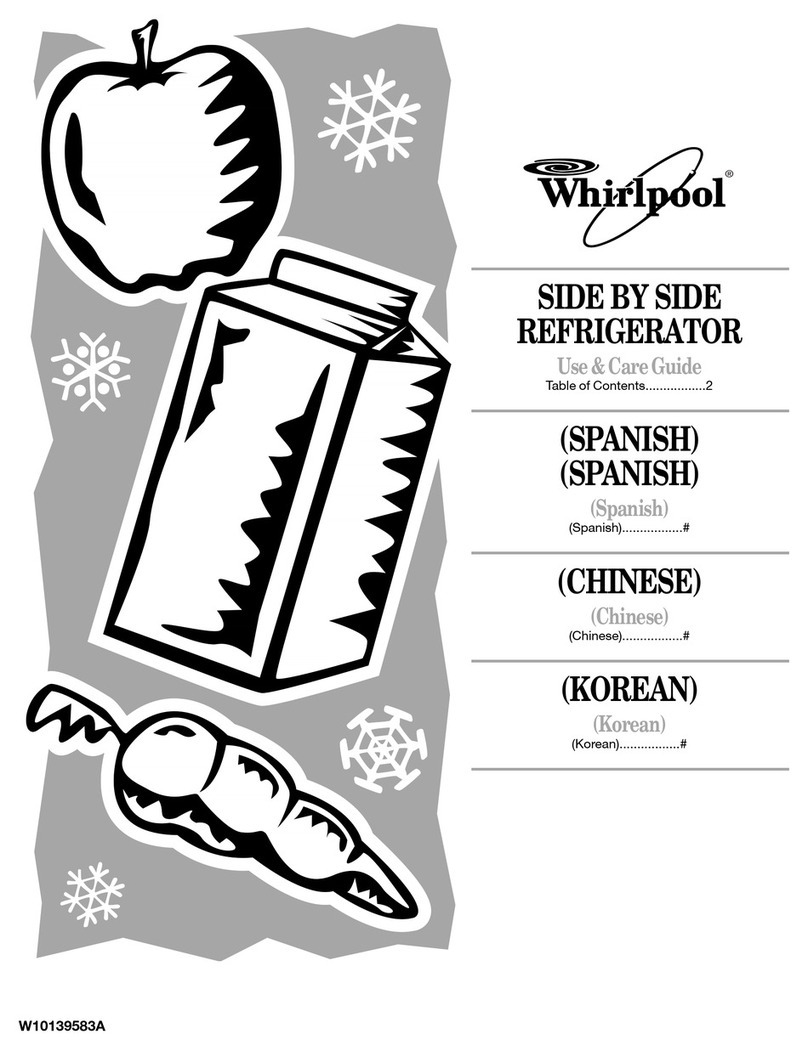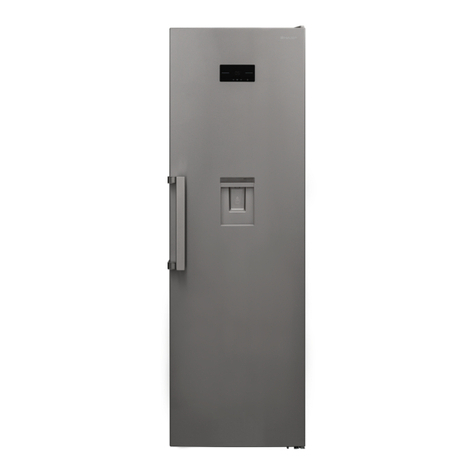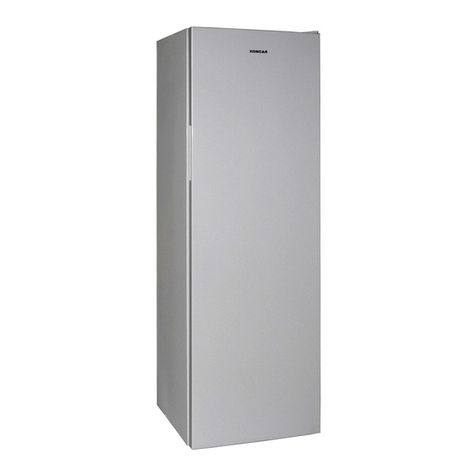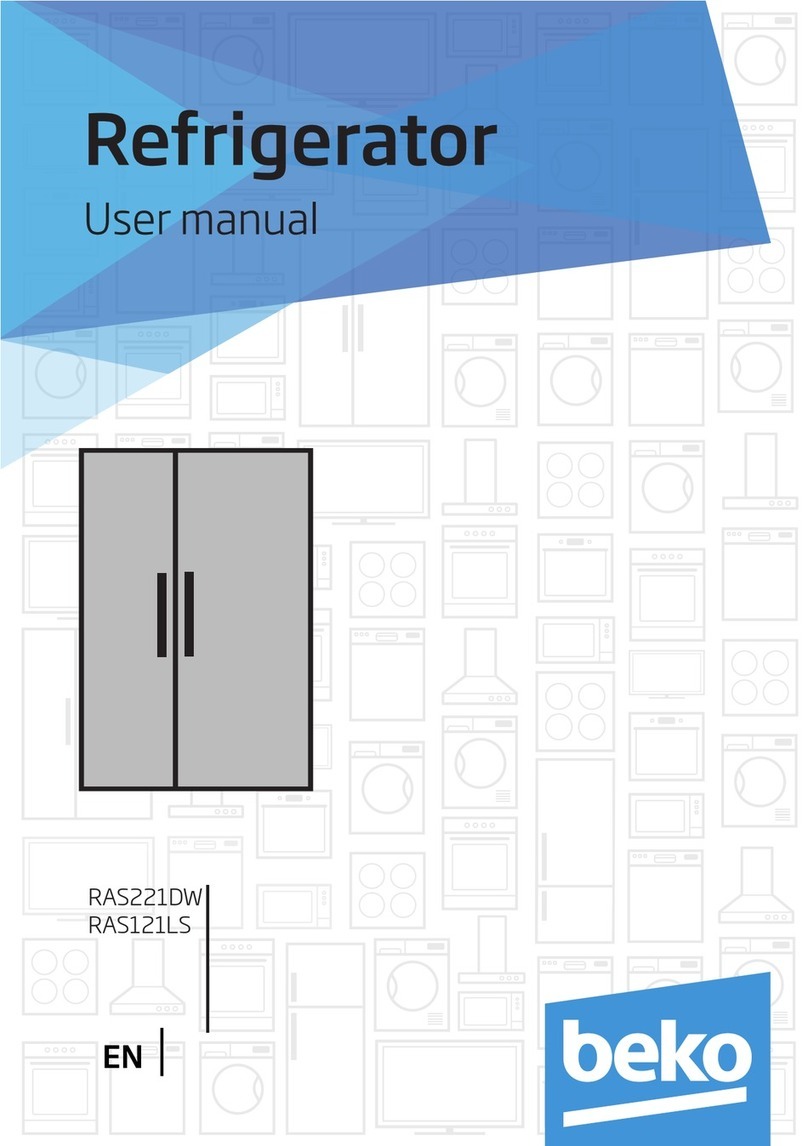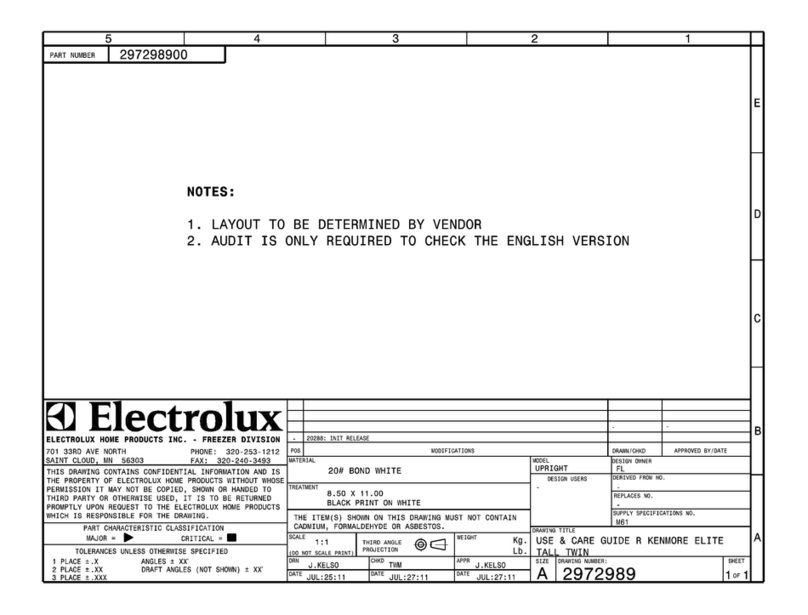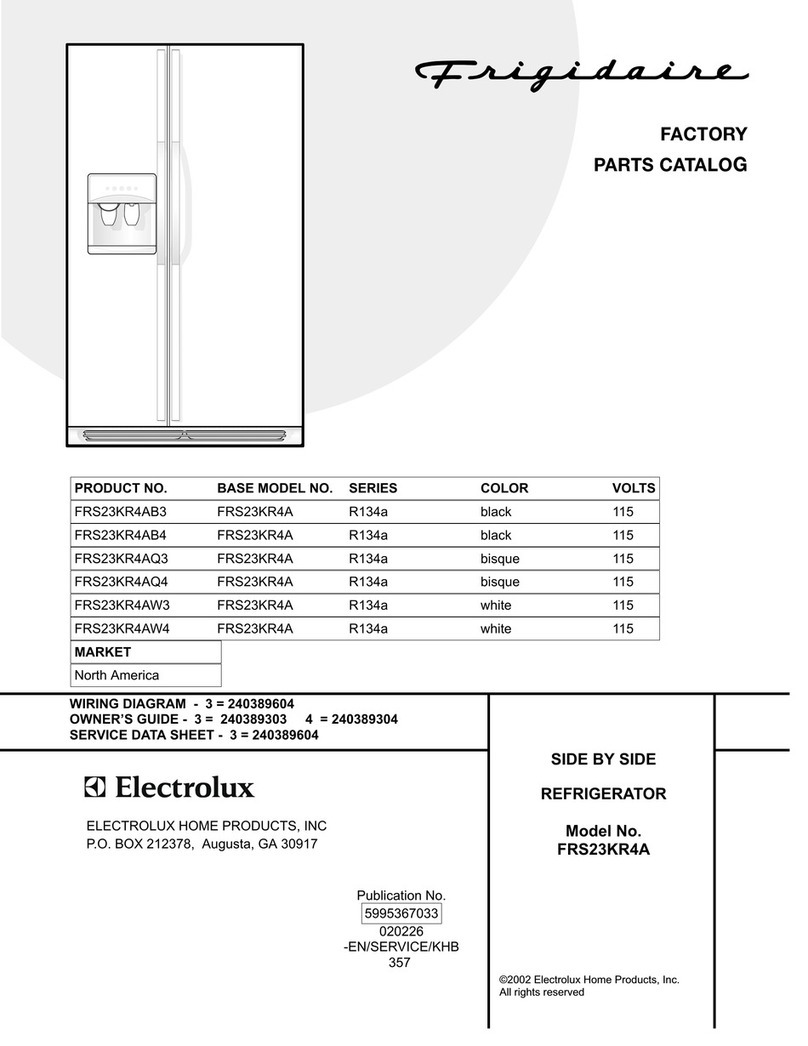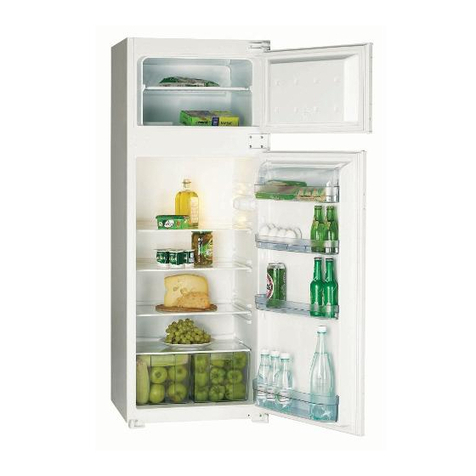SnackMate SMRA-4 User manual

Compact Refrigerator
Congélateur Compact
Congelador Compacto
User Manual
SMRA-4
Guide d'utilisation
SMRA-4
Manual del Usuario Modelo
SMRA-4


SAFETY PRECAUTIONS
Read all of the instructions before using this appliance. When using this
appliance, always exercise basic safety precautions, including the
following:
1) Use this appliance only for its intended purpose as described in this use
and care guide.
2) This refrigerator must be properly installed in accordance with the
installation instructions before it is used. See grounding instructions in
the installation section.
3) Never unplug your refrigerator by pulling on the power cord. Always
grasp the plug firmly and pull straight out from the outlet.
4) Repair or replace immediately all electric service cords that have
become frayed or otherwise damaged. Do not use a cord that shows
cracks or abrasion damage along its length, the plug or the connector
end.
5) Unplug your refrigerator before cleaning or before making any repairs.
Note: If for any reason this product requires service, we strongly
recommend that a certified technician performs the service.
6) Do not use any electrical device or any sharp instrument in
defrosting your refrigerator.
7) If your old refrigerator is not being used, we recommend that you
remove the doors and leave the shelves in place. This will reduce the
possibility of danger to children.
8) After your refrigerator is in operation, do not touch the cold
surfaces in the freezer compartment, particularly when hands are damp
or wet. Skin may adhere to these extremely cold surfaces.
9) Do not refreeze foods which have been thawed completely. The United
States Department of Agriculture in Home and Garden Bulletin No. 69
reads: "…You may safely refreeze frozen foods that have thawed if
they still contain ice crystals or if they are still
cold-below 40˚F".
"…Thawed ground meats, poultry, or fish that have any off-odor
or off-color should not be refrozen and should not be eaten.
Thawed ice cream should be discarded. If the odor or color of any food
is poor or questionable, discard it. The food may be dangerous to eat."
21
English
English

Thank you for using our Snackmate
product. This easy-to-use manual
will guide you in getting the best
use of your refrigerator.
Remember to record the model
and serial number. They are on the
inside right liner of the refrigerator.
Model number
Serial number
Date of purchase
Staple your receipt to your manual. You will need it to obtain
warranty service.
"…Even partial thawing and re-freezing reduce the eating quality of
foods, particularly fruits, vegetables, and prepared foods. The
eating quality of red meats is affected less than that of many other
foods. Use refrozen foods as soon as possible, to save as much of its
eating quality as you can."
10) This refrigerator should not be recessed or built in an enclosed
cabinet. It is designed for freestanding installation only.
11) Do not operate your refrigerator in the presence of explosive fumes.
SAVE THESE INSTRUCTIONS
For Future Reference Please
DANGER
Risk of child entrapment. Before you throw away your old
refrigerator or freezer, take off the doors. Leave the shelves
in place so that children cannot easily climb inside.
21
English
English

3
English
English
Table Of Contents
PAGE
Safety Precautions......................................................................1
Parts And Features .....................................................................4
Installing Your Refrigerator .......................................................5
Unpacking Your Refrigerator .............................................................5
Leveling Your Refrigerator .................................................................5
Proper Air Circulation.......................................................................5
Electrical Requirements .....................................................................6
Door Alignment ...............................................................................7
Door Reversal..................................................................................8
Refrigerator Features And Use..................................................... 10
General Features ...........................................................................10
Refrigerator Interior Shelves.............................................................10
Dispense-A-Can™ ..........................................................................11
Defrosting .....................................................................................11
Food Storage Information ...............................................................12
Normal Operating Sounds..............................................................12
Proper Refrigerator Care and Cleaning..................................13
Cleaning and Maintenance.............................................................13
Power Interruptions.........................................................................13
Vacation and Moving Care.............................................................13
Troubleshooting.........................................................................14
Warranty Information..............................................................15

4
1. Ice Compartment
2. Ice Cube Tray
3. Drip Tray
4. Adjustable Temperature Control
5. Slide-Out Shelves
6. Retainer Bar
7. Adjustable Front Leveling Leg
(not shown)
8. “Dispense-A-Can™” can storage
9. Fixed Door Shelf
10.Screw Hole Plug
2
3
4
5
6
7
8
9
1
English
English
Parts And Features
10

5
English
English
Installing Your Refrigerator
Unpacking Your Refrigerator
1. Remove all packaging material. This includes the foam base and
all adhesive tape holding the refrigerator accessories inside and
outside.
2. Inspect and remove any remains of packing, tape or printed
materials before powering on the refrigerator.
Leveling Your Refrigerator
• Your refrigerator has two leveling legs which are located in the
front corners of your refrigerator. After properly placing your
refrigerator in its final position, you can level your refrigerator.
• Leveling legs can be adjusted by turning them clockwise to raise your
refrigerator or by turning them counterclockwise to lower your
refrigerator. The refrigerator door will close easier when the
leveling legs are extended.
Proper Air Circulation
• To assure your refrigerator works at the maximum efficiency it was
designed for, you should install it in a location where there is proper air
circulation, plumbing and electrical connections.
• The following are recommended clearances around the refrigerator:
Sides……………3/4" (19mm)
Top....................2" (50mm)
Back..................2" (50mm)

6
English
English
Electrical Requirement
• Make sure there is a suitable power outlet (120 volts, 60 Hz
outlet) with proper grounding to power the refrigerator.
• Avoid the use of three plug adapters or cutting off the third grounding in
order to accommodate a two plug outlet. This is a dangerous
practice since it provides no effective grounding for the refrigerator and
may result in shock hazard.
Use of Extension Cords
• Avoid the use of an extension cord because of potential safety
hazards.
Install Limitations
• Do not install your refrigerator in any location not properly insulated
or heated ex. garage etc. Your refrigerator was not designed to
operate in temperature settings below 55˚ Fahrenheit.
• Select a suitable location for the refrigerator on a hard even
surface away from direct sunlight or heat source ex. radiators,
baseboard heaters, cooking appliances etc. Any floor unevenness should
be corrected with the leveling legs located on the front bottom corners of
the refrigerator.

Door Alignment (see fig. # 1)
1. Remove the top hinge cover.
2. Loosen the top hinge screws using a Phillips head screwdriver.
3. Adjust the door or put a spacer in between and then tighten the screws.
4. Replace the top hinge cover.
fig. # 1
English
English
7

Reversing the Door Hinge
1. Remove the top hinge cover. (see fig. # 1)
2. Using a Phillips head screwdriver, loosen and remove the screws
holding the top hinge in place. (see fig. # 1)
3. Remove the top hinge and carefully lift off the door.
4. Remove the screw hole plug from the opposite side and insert the
plug in the screw hole openings of the just removed screws. (see fig. # 2)
5. Remove the door pin from the bracket of the lower hinge by turning
counter clockwise. Move the pin to the opposite hole and tighten.
(see fig. # 3)
6. Loosen the screws holding the lower hinge bracket and remove the
hinge.(see fig. # 3)
7. Align the holes in the lower hinge bracket to the corresponding holes
in the opposite side of the cabinet. Insert and tighten the screws.
(see fig. # 3)
8. Align the bottom hole on the left side of the door with the pin of the lower
hinge and slide into place.
fig. # 2
screw hole plugs
English
English
8

9. Align the pin of the top hinge with top hole on the left side of the door
and push into place. Replace the screws in the upper hinge bracket but
do not tighten all the way. (see fig. # 2)
10. Make sure the door closes easily but forms a tight seal. Adjust the door
as needed. Once you are satisfied with the door alignment, completely
tighten the upper door hinge screws.
11. Replace the hinge cover. (see fig. # 2)
12. If the door does not close properly, refer to the section titled
“Door Alignment.”
NOTE: As the door gets pressed in during shipping, after reversing the door the
gasket may have to be reset. This is done to prevent the cool refrigerated
air from escaping. If there is a gap between the door gasket and the
cabinet, set the gasket by gently pulling it out to seal the gap.
fig. # 3
door pin
lower hinge bracket
screw hole plug
English
English
9

fig. # 4
English
English
10
Refrigerator Features And Use
General features adjustable temperature dial:
Your refrigerator will automatically maintain the temperature level you select.
The temperature control dial has 7 settings plus off. 1 is the warmest. 7 is the
coldest. Turning the dial to OFF stops cooling in both the refrigeration and ice
compartment. At first, set the dial to 4 and allow 24 hours to pass before
adjusting the temperature to your needs.
(Note: If the refrigerator has been placed in a horizontal or tilted
position for any period of time wait 24 hours before plugging the
unit in.)
Refrigerator Interior Shelves
To remove or replace a full-width slide-out shelf:
(see fig. # 4)
1. Gently tilt the shelf up and slide forward until the shelf has been
completely removed.
2. To replace the shelf, gently slide the shelf back.

fig. # 7
drip tray
fig. # 5
English
English
11
Using the Dispense-A-Can™
• Your refrigerator is equipped with the convenient “Dispense-A-Can™”
compartment. Each compartment will hold up to four cans. Simply load the
cans from the top. To dispense a can, simply draw one out from the bottom.
Defrosting Your Refrigerator (see Fig. # 7)
• To set the timer to the defrost cycle, follow the instructions on the timer that is
located on the back of the unit. Make sure the drip tray is under the freezer
section. Defrosting may take a few hours.
• The drip tray on your refrigerator is designed to drain away the defrosted
water to the drip pan on the compressor. Here the water will evaporate.

English
English
12
Food Storage Information
Fresh Food
• When storing fresh food that is not prepackaged, be sure to wrap or store food
in airtight and moisture-proof material unless otherwise noted. This will ensure
proper shelf life and prevent the transfer of odors and tastes.
• Wipe containers before storing to avoid needless spills.
• Eggs should be stored in an upright position in their original carton to
maximize shelf life.
• Fruit should be washed and dried, then stored in sealed plastic bags before
storing in the refrigerator.
• Vegetables with skins should be stored in plastic bags or containers.
• Leafy vegetables should be washed and drained and then stored in plastic
bags or containers.
• Hot food should be allowed to cool before storing in the refrigerator. This will
prevent unnecessary energy use.
• Fresh seafood should be used the same day as purchased.
• When storing meats in the fresh food section, keep in the original
packaging or rewrap as necessary. Follow the suggestions below for
safe storage:
• Chicken 1-2 Days
• Ground Beef 1-2 Days
• Cold Cuts 3-5 Days
• Steaks/Roasts 3-5 Days
• Smoked/Cured Meats 7-10 Days
• All others 1-2 Days
Normal Operating Sounds You May Hear
• Boiling water, gurgling sounds or slight vibrations that are the result of the
refrigerant circulating through the cooling coils.
• The thermostat control will click when it cycles on and off.

English
English
13
Proper Refrigerator Care and
Cleaning
Cleaning and Maintenance
Warning: To avoid electric shock always unplug your refrigerator
before cleaning. Ignoring this warning may result in death
or injury.
Caution: Before using cleaning products, always read and follow
manufacturer’s instructions and warnings to avoid personal
injury or product damage.
General: • Prepare a cleaning solution of 3-4 tablespoons of baking
soda mixed with warm water. Use sponge or soft cloth,
dampened with the cleaning solution, to wipe down
your refrigerator.
• Rinse with clean warm water and dry with a soft cloth.
• Do not use harsh chemicals, abrasives, ammonia,
chlorine bleach, concentrated detergents, solvents or
metal scouring pads. Some of these chemicals may
dissolve, damage and/or discolor your refrigerator.
Door Gaskets: • Clean door gaskets every three months according to
general instructions. Gaskets must be kept clean and
pliable to assure a proper seal.
• Petroleum jelly applied lightly on the hinge side of gaskets
will keep the gasket pliable and ensure a good seal.
Power Interruptions
• Occasionally there may be power interruptions due to thunderstorms or other
causes. Remove the power cord from AC outlet when a power outage occurs.
When power has been restored, replug power cord to AC outlet. If outage is
for a prolonged period, inspect and discard spoiled or thawed food in freezer
and refrigerator. Clean
refrigerator before reusing.
Vacation and Moving Care
• For long vacations or absences, empty food from refrigerator and freezer, move
the temperature dial to the off position and clean the refrigerator and door
gaskets according to "General cleaning" section. Prop doors open,
so air can circulate inside. When moving always move the refrigerator
vertically. Do not move with the unit lying down. Possible damage to the
sealed system could occur.

English
English
14
Troubleshooting
Refrigerator Does Not Operate
• Check if thermostat control is not in the “OFF” position.
• Check if refrigerator is plugged in.
• Check if there is power at the ac outlet, by checking the
circuit breaker.
Food temperature feels too warm
• Reduce frequent door openings.
• Allow time for recently added warm food to reach fresh food or
freezer temperature.
• Check gaskets for proper seal.
• Clean condenser coils.
• Adjust temperature control to colder setting.
Food temperature is too cold
• If temperature control setting is too cold, adjust to a warmer setting
and allow several hours for temperature to adjust.
Refrigerator runs too frequently
• This may be normal to maintain constant temperature during high
temperature and humid days.
• Doors may have been opened frequently or for an extended period
of time.
• Clean condenser coils.
• Check gasket for proper seal.
• Check to see if doors are completely closed.
Moisture build-up on interior or exterior
of the refrigerator:
• This is normal during high humidity periods.
• Reduce prolonged or frequent door openings.
• Check door gaskets for proper seal.
Refrigerator has an odor:
• Interior needs cleaning.
• Foods improperly wrapped or sealed are giving off odors.
Refrigerator door does not shut properly:
• Level the refrigerator.
• Re-align refrigerator door.
• Check for blockages e.g. food containers, crisper cover, shelves,
bins etc.

Français
English
15

Français
English
1
MESURES DE SÉCURITÉ
Lire l’ensemble des instructions avant d’utiliser l’appareil. Lors de
l’utilisation de cet appareil, prendre toutes les mesures de sécurité de
base, y compris les suivantes:
1) N’utiliser cet appareil que pour l’usage pour lequel il est prévu, tel qu’il
est indiqué dans le guide d’utilisation et d’entretien.
2) Ce réfrigérateur doit être correctement installé conformément aux
instructions d’installation avant d’être utilisé. Consulter les instructions de
mise à la terre du chapitre Installation.
3) Ne jamais tirer sur le cordon d’alimentation pour débrancher le
réfrigérateur. Toujours saisir fermement la fiche et la retirer
complètement de la prise.
4) Réparer ou remplacer immédiatement tout cordon électrique effiloché ou
endommagé d’une quelconque manière. Ne pas utiliser un cordon
fissuré, abrasé ou dont la prise ou le connecteur est endommagé.
5) Débrancher le réfrigérateur avant de le nettoyer ou d’effectuer des
réparations. Remarque: Si ce produit doit faire l’objet d'un entretien
pour quelque raison que ce soit, il est vivement recommandé de confier
cette tâche à un technicien agréé.
6) Ne pas utiliser d’appareils électriques ou d’objets pointus pour dégivrer
le réfrigérateur.
7) Si vous n’avez plus l’usage de votre ancien réfrigérateur, nous vous
conseillons d’en retirer les portes. Ceci permet d’éviter tout danger
potentiel pour les enfants.
8) Une fois le réfrigérateur en fonctionnement, ne pas toucher les
surfaces froides du compartiment de congélation, en particulier avec
des mains mouillées ou humides. La peau risquerait d’adhérer à ces
surfaces extrêmement froides.
9) Ne pas recongeler les aliments qui ont été complètement décongelés.
Le bulletin Maisons et Jardins du Ministère de l’Agriculture des
États-Unis n° 69 stipule que: « ...Les aliments congelés peuvent être
recongelés en toute sécurité s’ils contiennent toujours des cristaux de
glace ou si leur température reste inférieure à 4, 5°C".
« …Les viandes hachées, la volaille et le poisson présentant une odeur
désagréable ou une couleur suspecte ne doivent ni être recongelés, ni
être consommés. La crème glacée décongelée doit être jetée. Tout
aliment présentant une odeur ou couleur douteuse doit être jeté.
L’ingestion d’un aliment de ce type peut s’avérer dangereuse. »

Français
« …La décongélation ou la recongélation, même partielle, fait
diminuer le goût des aliments, en particulier des fruits, légumes et plats
préparés. Le goût des viandes rouges est affectée à un bien moindre degré
que celle de nombreux autres aliments. Utiliser les aliments recongelés dès
que possible, afin de conserver le goût.»
10) Ce réfrigérateur ne doit être ni encastré, ni enfermé dans un placard. Il a été
conçu pour être installé tel qu’il se présente.
11) Ne pas faire fonctionner le congélateur en présence de fumées pouvant
entraîner une explosion.
VEUILLEZ CONSERVER CES
INSTRUCTIONS
2

Français
3
DANGER
Les enfants pourraient se retrouver coincés dans votre
réfrigérateur ou congélateur usagé avant que vous ne puis-
siez vous en débarrasser. Retirer les portes. Laisser les
étagères en place de manière à ce que les enfants ne
puissent pas grimper facilement à l’intérieur".
Nous vous remercions d’avoir
choisi cet appareil Snackmate. Ce
guide d'utilisation facile vous
permet de profiter d'une utilisation
optimale de votre réfrigérateur.
Ne pas oublier de noter le numéro
de modèle et de série. Ces numéros
se trouvent à droite à
l'intérieur du réfrigérateur.
Numéro de modèle
Numéro de série
Date d’achat
Agrafer le reçu de caisse au guide. Il devra être présenté pour tout
service après-vente sous garantie.
Other manuals for SMRA-4
1
Table of contents
Languages:
Other SnackMate Refrigerator manuals

